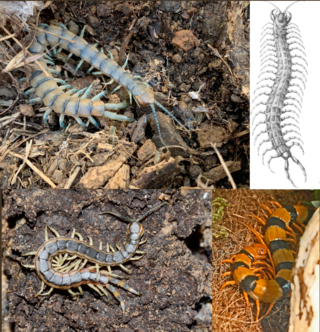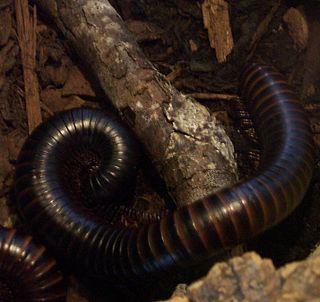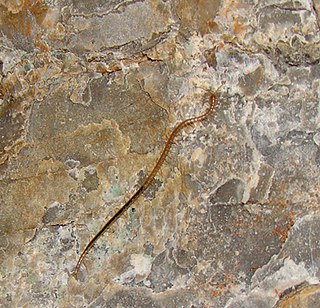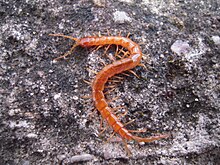
Lithobius is a large genus of centipedes in the family Lithobiidae, commonly called stone centipedes, common centipedes or brown centipedes.

Cormocephalus is a genus of centipedes of the family Scolopendridae, containing the following species:

Scolopendra is a species-rich genus of large tropical centipedes of the family Scolopendridae.

Spirostreptus is a genus of giant millipedes of the family Spirostreptidae. It contains the following species:

Newportia is a genus of scolopocryptopid centipedes. It has around 50 described species to date.
Pachymerium is a genus of centipedes in the family Geophilidae found mainly in the west Palearctic region and in south Africa. Centipedes in this genus feature an elongate head, scattered coxal pores, and sternal pores in a pair of anterior groups and a posterior transverse band; the forcipular coxosternite is broad, and the ultimate article of the forcipule has a prominent basal denticle.

Bothropolys is a genus of centipedes in the family Lithobiidae.

Geophilus is a large, heterogeneous genus of soil centipedes in the family Geophilidae largely considered to be synonymous with Brachygeophilus. The generic name first appeared in Brewster's Edinburgh Encyclopaedia in 1814 as Geophilus electricus. This genus has a Holarctic distribution.

Trigoniulus is a genus of millipede in the family Trigoniulidae. There are at least 90 described species in Trigoniulus.

Otostigmus is a genus of centipedes in the family Scolopendridae. It was first described by Swedish naturalist Carl Oscar von Porat in 1876. The genus as a whole comprises around 157 species, found primarily in the Neotropics.

Ribautia is a genus of centipedes in the family Geophilidae. This genus was described by French myriapodologist Henry Wilfred Brolemann in 1909. Centipedes in this genus are found in South America, tropical Africa, Madagascar, the Arabian peninsula, Australia, New Zealand, and Melanesia.
Tuoba is a genus of 17 species of centipedes, in the family Geophilidae. This genus was described by American biologist Ralph Vary Chamberlin in 1920. These centipedes are found in coastal regions and islands in the Mediterranean and in the Atlantic, Pacific, and Indian oceans.
Mecistocephalus is the largest genus of centipedes in the family Mecistocephalidae, with about 140 species. This genus is among the most diverse and widespread of all the genera in the order Geophilomorpha. The British entomologist George Newport first proposed this genus in 1843 to contain a group of centipedes marked by an unusual elongation of the head.
Schendyla is a genus of soil centipedes in the family Schendylidae. These centipedes are found in the west Palearctic region. This genus was described by Danish entomologists Vilhelm Bergsøe and Frederik Vilhelm August Meinert in 1866. This genus now includes more than 20 species.

Lamyctes is a genus of centipedes in the family Henicopidae. It was described by Danish entomologist Frederik Vilhelm August Meinert in 1868.

Australobius is a genus of centipedes in the family Lithobiidae. It was described by American biologist Ralph Vary Chamberlin in 1920.
Pectiniunguis is a genus of centipedes in the family Schendylidae. This genus was described by American naturalist Charles Harvey Bollman in 1889. Centipedes in this genus feature second maxillae with claws fringed by two rows of filaments, transversally elliptical sternal pore-fields on almost all trunk segments, two pores on each coxopleuron, and ultimate legs without claws.
Ityphilus is a genus of centipedes in the clade Ballophilidae. It was described by American myriapodologist Orator Fuller Cook in 1899. Centipedes in this genus feature distinctly club-like antennae, well marked sclerotized lines on the forcipular coxosternite, and two pores on each coxopleuron. These centipedes range from about 1 cm to about 9 cm in length and have 41 to 113 pairs of legs. The dwarf species Ityphilus donatellae ranges from 8.5 to 11 mm in length and can have as few as 41 leg pairs, the minimum number found in this genus. The large species I. grandis can reach 93 mm in length and have as many as 113 leg pairs, the maximum number found in the clade Ballophilidae.

Otostigminae is a large subfamily of centipedes, containing nearly half of all species in the family Scolopendridae. Members of this subfamily are abundant and widespread throughout the tropical and subtropical regions of the world, mostly in Africa, Asia, and Australia.
Schendylops is the largest genus of centipedes in the family Schendylidae, containing more than 60 species. This genus was first proposed by the American biologist Orator F. Cook in 1899 for the type species originally named Schendyla grandidieri in 1897. Most species in this genus are found in the Neotropical region, but a dozen species are found in Africa and Madagascar. These species live in diverse habitats, ranging from sea level to high altitudes, e.g., at 4,500 m (14,800 ft) above sea level in the Andes mountains.













